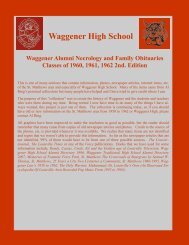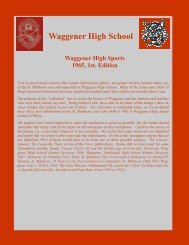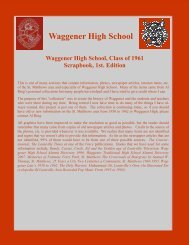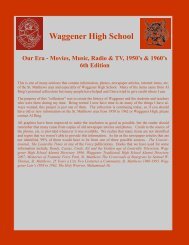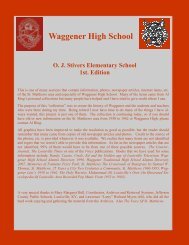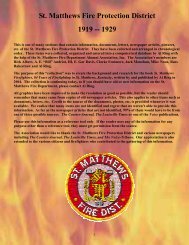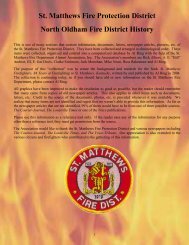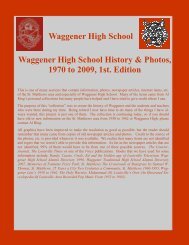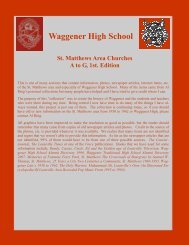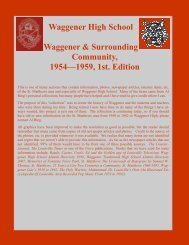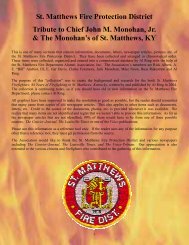The Courier-Journal, October 20, 1956:Louisville Wins Business AreaHe held that Louisville started annexation proceedings first, hence its claim to the business district is superior to that of theCity of St. Matthews.He ruled that Jude Jones in the 1955 trial should have directed a verdict in favor of annexation. Thus the reversal was directedto the judge, rather than the jury, which included 11 Louisvillians.Attorney Fields, <strong>com</strong>menting on this yesterday, said both sides in the case agreed at the trial that the jury would make thedecision.Finds Only Two Issues: Assistant City Attorney Frick later asked Judge Jones to grant the City a judgment despite thejury’s decision, or to grant a new trial. Jones refused, and the Case went to the Court of Appeals.Commissioner Cullen, in his finding yesterday, said there were only two legal issues in the lawsuit:1. The addition of the new territory “for the interest of the City (of Louisville)?”2. Will annexation “cause no manifest injury to the persons holding real estate in the territory sought to be annexed?”Gives His Conclusion: Cullen found that “within the realm of clear and obvious facts, it is difficult to. conceive of anysituation in which the annexation of urban territory to a city would be contrary to the interests of the city, except where theannexation would constitute an overextension of the capacities of the city to function as a sound, going concern.“In the case before us, there is no suggestion that Louisville is not a growing, prosperous city with a long experience ofgrowth or that its capacities will be overextended by annexation of the small area here in question.”No ‘Grievous Burden’: As to whether annexation would injure the property owners, Cullen wrote:‘There is - no question but that the annexed territory, being urban in nature, will receive benefits in the form of City servicesfrom Louisville.“The real question arises front the fact that the territory is now receiving what its residents consider to be adequate municipalservices, at a lower cost, from the City of St. Matthews and from a Volunteer Fire Department.”Cullen concluded, however, that annexation would not place upon the property owners any “grievous, wearisome, or oppressive,burdens.Realty Taxes Would Rise: Once annexation is <strong>com</strong>pleted, the Board of aldermen will be asked to appropriate money for afire station, traffic signals, and street lights, Owsley said. Regular City services, such as street cleaning and garbage collectionwould start immediately, he added.Owsley said a quad fire <strong>com</strong>pany, which would have a four purpose truck, probably would be installed in the business area.Meanwhile, the City would contract with the St. Matthews Volunteer Fire Department and perhaps reshuffle its existingequipment to provide coverage. This probably would result in an immediate drop in fire-insurance rates. Owsley said.Real-estate taxes in the annexed area would go up from the St. Matthews 60-cent rate to $1.50 However, no City tax ‘billswould go out until January, 1958.Water Rates Would Drop: Water rates Would decline 33½ per cent. Sewer rates would remain the same.People who work in the annexed area and business owners in it would pay the City’s 1¼ per cent occupational tax on earningsand net profits.Six other suits involving annexation attempts by the City of Louisville may depend on the out<strong>com</strong>e of the current ease,Court action has been held up pending the St. Matthews decision.Lists The Others: Assistant City Attorney Frick listed the areas as follows:The “Rubbertown” area, from Algonquin Parkway to Cane Run Road, between Bells Lane and the Ohio River; WestBuechel and part of the unincorporated Buechel area; Rolling Fields; Ridgewood; Lincolnshire and part of St. Regis Park,and Meadowbrook Estates.The City can move to have the suits reinstated, using the Court of Appeals decision on the St. Matthews business district asa legal precedent.Since 1946, the City of Louisville also has made three major—and unsuccessful—efforts to annex the St. Matthews residentialarea. The City of St. Matthews meantime has <strong>com</strong>pleted annexation of the residential area.
The Voice Of St. Matthews, January 3, 1957: <strong>High</strong>light 1956Mallon Plan, Church Growth, Court Decision <strong>High</strong>light 1956Building Of Homes Was Off 25%The big stories in St. Matthews for the year 1956 were the defeat of the Mallon Plan, the defeat of the school tax, the Courtof Appeals decision giving Louisville the right to annex part of the St. Matthews business district, the growth of localchurches and new big buildings finished here or projected for 1957.There were many other stories, of course, some of them good and some bad.Home-building in this area was off about 25 percent a V.A. and G.I. loans be<strong>com</strong>e increasingly difficult to get. Commercialconstruction was way down. Few new businesses opened.The school population continued to increase, and some schools added wings, but no new schools were built.The St. Matthews Y.M.C.A. continued to expand and grow. A new theatre group was started—under the auspices of the Y.The older Theatre groups—the St. Matthews Community Theatre, the Y.M.H.A. and Lyndon Theatres, the Anchorage Children'sTheatre-continued their yearly drama programs.Sports programs in this area were greatly expanded, as a new Babe Ruth League Baseball program came into being, and St.Matthews Little League built a second park.Trinity became a full-fledged high school and its athletic teams, along with those of Eastern <strong>High</strong>, at times threatened tomake the East End the scourge of the County and State.Annexation Plan: The Mallon Plan was essentially simple. Put together by a <strong>com</strong>mittee of private citizens appointed bythe County Judge and the Mayor of Louisville, the Plan derived its name from the <strong>com</strong>mittee chairman John Mallon.Under the Plan, Louisville would annex all its urbanized suburbs. This would have included 46 square miles and 68,000people. It would have taken in Shively, St. Matthews, and the 15 incorporated Cities in the St. Matthews area, besides adozen others in the County.The State Legislature passed the necessary law to put the Plan in effect, providing that a majority of the people in the suburbsand in Louisville voted for the Plan.Under the Plan, the suburban cities would agree to turn over their assets and liabilities to the City of Louisville. Theywould be required to pay Louisville's $1.50 property tax rate.In return Louisville would provide municipal services. The Metropolitan Sewer district under the Plan would have extendedsewers into the suburbs over a six-year period.M.S.D. would take over St. Matthews Sanitation District NI. 1 and grant the home-owners of the district a slight reductionin sewer rates. Water rates would also be reduced. Nothing was said about schools.Opposition Aroused: The Plan ran into trouble in late summer. The Suburban Citizens <strong>com</strong>mittee, made up of suburbanhomeowners and some sixth-class City officials, organized a propaganda drive pointing out the short<strong>com</strong>ings of the Plan.Cherrywood Village trustees and the St. Matthews Jaycees came out against the plan.But more important than all of these was the sometimes active but always fairly quiet, resistance of the suburban residentsand leaders.People didn’t trust Louisville. They don’t believe annexation was the answer to Louisville problems, or to that of the suburbs.They felt they could handle their own affairs better, either individually, or through their small Cities, which hadproved able to provide garbage, fire and police services at reasonable rates.Another factor was the cost. The Mallon Committee produced figures showing that annexation by Louisville would costmost suburban residents $5 to $80 a year more. This undoubtedly influenced some people.Over television and radio, in the newspapers, and on public platforms, the debate raged during the summer and fall. Speakerswent to scores of P.T.A. meetings, civic club affairs, and other gatherings to denounce or support the plan.Suburbs Defeat It: The downtown daily newspaper supported the Plan. The Voice and other suburban newspapers opposedit. It is doubtful if the pros and cons of any other local public issue had ever been so thoroughly discussed in publicand private.Election Day was Nov. 6. The people of Louisville voted for the Plan by about 36,000 votes to 24,000.But the people of the suburbs rejected it by two-to-one. The vote in A district <strong>com</strong>prising the greater St. Matthews area,was unofficially, 8,986 against, and only 4,585 for.
- Page 2 and 3: Explanation of the following pages,
- Page 4 and 5: The Voice of St. Matthews, April 20
- Page 6 and 7: The Voice of St. Matthews, April 20
- Page 8 and 9: The Voice of St. Matthews: July 17
- Page 10 and 11: The Voice of St. Matthews: Septembe
- Page 12 and 13: The Voice of St. Matthews, Septembe
- Page 14 and 15: The Voice of St. Matthews, Septembe
- Page 16 and 17: The Voice of St. Matthews, January
- Page 18 and 19: The Voice of St. Matthews, January
- Page 20 and 21: The Voice of St. Matthews:1955 Adve
- Page 22 and 23: The Voice of St. Matthews, May 5, 1
- Page 24 and 25: The Voice of St. Matthews, January
- Page 26 and 27: The Voice of St. Matthews, January
- Page 28 and 29: The Voice of St. Matthews, January
- Page 30 and 31: The Voice of St. Matthews, January
- Page 32 and 33: The Voice of St. Matthews, January
- Page 34 and 35: The Courier-Journal, October 20, 19
- Page 38 and 39: The Voice Of St. Matthews, January
- Page 40 and 41: The Voice Of St. Matthews, January
- Page 42 and 43: The Voice Of St. Matthews, January
- Page 44 and 45: The Voice Of St. Matthews, January
- Page 46 and 47: The Voice Of St. Matthews, January
- Page 48 and 49: The Voice Of St. Matthews, January
- Page 50 and 51: The Voice Of St. Matthews, February
- Page 52 and 53: The Voice Of St. Matthews, July 18,
- Page 54 and 55: The Voice of St. Matthews, August 1
- Page 56 and 57: The Voice of St. Matthews, August 1
- Page 58 and 59: The Voice of St. Matthews, January
- Page 60 and 61: The Voice of St. Matthews, January
- Page 62 and 63: The Voice of St. Matthews, January
- Page 64 and 65: The Voice of St. Matthews, January
- Page 66 and 67: The Voice of St. Matthews, January
- Page 68 and 69: The Voice of St. Matthews, January
- Page 70 and 71: The Voice of St. Matthews, January
- Page 72 and 73: The Voice of St. Matthews, April 2,
- Page 74 and 75: The Voice of St. Matthews, July 16,
- Page 76 and 77: The Voice of St. Matthews, July 16,
- Page 78 and 79: The Voice of St. Matthews, July 16,
- Page 80 and 81: The Voice of St. Matthews, July 16,
- Page 82 and 83: The Voice of St. Matthews, July 16,
- Page 84 and 85: The Voice of St. Matthews, July 16,
- Page 86 and 87:
The Voice of St. Matthews, July 16,
- Page 88 and 89:
The Voice-Jeffersonian, April 9, 19
- Page 90 and 91:
The Voice-Jeffersonian, April 9, 19
- Page 92 and 93:
The Voice-Jeffersonian, April 9, 19
- Page 94 and 95:
The Voice-Jeffersonian, April 9, 19
- Page 96 and 97:
Jim Herron Collection:L & N St. Mat
- Page 98 and 99:
The Voice, July 25, 1974:Reading it
- Page 100 and 101:
The Voice, July 25, 1974:25th Anniv
- Page 102 and 103:
The Voice, July 25, 1974:falling li
- Page 104 and 105:
The Voice, July 25, 1974:Under Ogle
- Page 106:
The Voice, July 25, 1974:25th Anniv



